Notes of chapter: Sound are presented below. Indepth notes along with worksheets and NCERT Solutions for Class 9.
(1)Sound-
Sound is a form of energy which produces a sensation of hearing (vibration)through a transmission medium such as gas, liquid and solid.
Eg:- (i) Touch school bell when producing sound, you will feel vibration.
(ii) Tie rubber band from both ends and vibrate them, you will hear a sound.
Sound can be produced by striking, scratching, plucking, rubbing, blowing or shaking different objects.
Eg:- (i) When we rub our hand, sound has produced.
(ii) When we strike a hammer on iron sheet, sound has produced.
(iii) When we scratch card by coin, sound has produced.
(iv) When we blow a pipe. Sound has produced.
(v) When we shake ice in a glass, sound has produced.
(2) Vibration-
Vibration is an oscillation motion (to and fro motion) of an object.
Eg:- (i) Vibrate a dish fill with water, you will hear sound.
(ii) Musical instruments make vibration and we can hear sound.
Characteristics of the vibration of sound-
(i) Frequency of oscillations-
The number of oscillations per second is known as frequency of oscillations.
Therefore, the number of compression or rarefaction that crosses our ear per unit time is known as frequency of sound waves.
Its unit is hertz(Hz).It is usually represented by ν (nu).
When sound is propagated through a medium, the density of the medium oscillates between a maximum value and a minimum value. The change in density from the maximum value to the minimum value, then again to the maximum value, makes one complete oscillation.
Eg:- If an object oscillate 30 times per second, then hat would be its frequency?
Ans– The object oscillate 30 times in a second.
Therefore, frequency of that object is 30 Hz.
(ii) Amplitude-
The maximum extent of a vibration from the point of equilibrium is known as amplitude of vibration. In other words, the maximum displacement of an object or a vibration is known as amplitude.

(iii) Time period-
Time taken to complete one oscillation is known as time period.
It is represented by T. Its SI unit is second.

Eg:- An object oscillate 30 times in 10 sec. Find out its time period.
Ans– Number of oscillations = 30
Time taken = 10 sec.
Time period = Time taken / Number of oscillations
= 10/30
= 0.33 sec
Hence, time period of the oscillation is .33 seconds.
(iv)Loudness-
Loudness of the sound is depends on the amplitude of the vibration of sound.
Eg:- (a) If the amplitude of vibration is large, the voice of sound produced will be loud.

(b) If the amplitude of vibration is small, the voice of sound produced will be weak or soft.

(v)Pitch-
Pitch (Shrillness) is a quality of sound which determines loudness (higher or lower) sound at the frequency of sound.
(a) The high frequency produces high pitch sound.

(b) The low frequency produces low pitch sound.

Eg:- Low- pitched and high – pitched sounds are tabulated below:-
| SN | Low – pitched sounds has low frequency | High – pitched sound has high frequency |
| 1 | Drum vibrates with low frequency | Whistle blows at the high frequency |
| 2 | Roar of lion is a low frequency vibration of sound | Birds makes a high – pitched frequency |
| 3 | Voice of a man | Voice of woman |
(3)Medium of the sound-
The matter or substance through which sound is transmitted is called a medium.
Eg:- Liquid, gas and solid
Sound needs medium to travel-
(i) Sound can travel in water.
Experiment
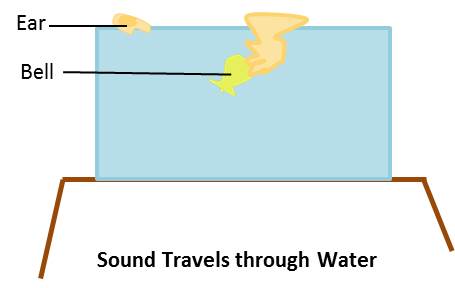
Fill a tub with water.Shake a bell inside the tub. Now put your ear at the surface of water and listen the sound of bell. Therefore, sound can travel in water.
(ii) Sound can travel in solids.
Experiment
Place your ear at the end of the wooden table and ask your friend to scratch or tap the table gently. You can hear the sound. Therefore, sound can travel through soilds.
(iii) Sound can travel through air.
Experiment
We can hear sound produced by other peoples, birds, animals etc . Therefore, sound can travel through air.
(iv) Sound can not travel through a vacuum.
Experiment

Take an airtight jar, an electric bell and a vacuum pump. Suspend the bell inside the jar and fit vacuum pump with jar. Now, press the bell switch, we can hear sound of bell. Now start vacuum pump, when air is pump out from the jar gradually, the sound of bell become fainter. When all air is pump out from the jar, we can not hear the sound of the bell.
Therefore, it is clear that sound needs a material medium for its propagation.
(4)Propagation of sound-
Sound moves from point of generation to our ear through a medium. When an object vibrates, it makes nearest particle of the medium to vibrate also. The particles of medium do not move to the ear but set adjacent particle of the medium to vibrate.
First particle of the object vibrates. Then it displaced (break) equilibrium of the particle of the medium and exerts a force on the particle of medium. As a result of exerting force, the particle of medium displaced from its position of rest. Now the particle of medium starts vibrating and set another adjacent new particle of medium to vibrate till sound reaches to our ear. After displacing the other adjacent particle, first particle comes back to its original position.
Therefore, it is clear that the disturbance created by the source of sound in the medium travels by the medium (Liquid, gas and solid) not by the particles of the medium. It is called propagation of sound. It shows that sound can be visualized as a wave.
Sound waves are characterised by the motion of particles in the medium and are called mechanical waves.
(i)Compression-
A compression is a region of high pressure in sound waves where particles of medium are very close.
When the sound object vibrates forward, it pushes and compresses the particles of medium in front of vibrating objects creating a region of high pressure. This region is called as compression (C).
(ii)Rarefaction-
A rarefaction (R) is a region of low pressure in sound waves where particles of medium are very far.
When the sound object vibrates backward, it creates a region of low pressure. This region is called as rarefaction (R).

(iii)As the object moves back and forth rapidly, a series of compression and rarefaction is created in the medium.

The speed of the sound depends on density of the medium. The pressure exerted by the particles of the medium is related to the number of the particles of a medium in a given volume. Therefore, more density of the particles in the medium gives more pressure and vice versa. Therefore, propagation of sound can be considered as propagation of density variations or pressure variations in the medium.
(iv)Wavelength-
The distance between two consecutive compression (C) or two consecutive rarefaction (R) is called wavelength.
It is represented by Greek letter λ.
Its SI unit is metre(m).
(5)Longitudinal waves-
Sound waves are longitudinal waves.
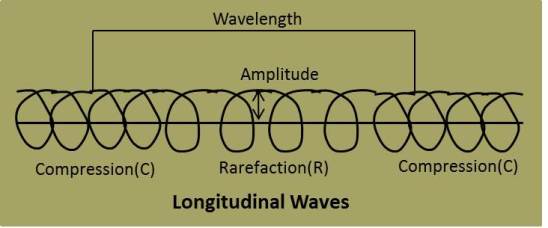
Longitudinal waves are waves in which particles of medium do not leave their places but oscillate back and forth their position of rest.
Sound waves also propagate in the same way. Therefore Sound waves are longitudinal waves.
(6)Transverse waves-
Transverse waves are those waves in which particles oscillate up and down about their mean position in a direction perpendicular to the direction of wave propagation.
Eg:- Waves produces in the water after dropping a pebble in a pond.
Light waves are transverse waves.


Eg:- A sound wave has a frequency of 200 Hz and its wavelength is .5 m. Find the speed of the sound of the wave.
Ans- Frequency of the sound wave = 200 Hz
Wavelength of the sound wave = .5 m
Speed of the sound, v = λν
= .5(200)
= 100 m/s
Hence, speed of the sound is 100 m/s.
(8)Intensity of the sound-
Intensity of the sound is the amount of sound energy that passing each second through unit area.
Differences between loudness and intensity of the sound
| SN | Loudness | Intensity |
| 1. | It is a measure of the response of the ear to the sound. | It is the amount of sound energy that passing each second through unit area. |
| 2. | It is vary from person to person. | It is not vary person to person. |
| 3. | It depends on the sensitivity of the ear. | It does not depend on the sensitivity of the ear. |
(9) Speed of the sound in different media-
(i)The speed of the sound depends on the medium of the sound.
(ii) The speed of the sound depends on the temperature of the medium. The speed of the sound increases with increase in the temperature of the medium.
(iii) The speed of the sound decreases when it goes from solid to gaseous state.
(10) The sound gets reflected at the surface of a solid and liquid.
The law of reflection of sound states that – “The directions in which the sound is incident and reflected make equal angles with the normal to the reflecting surface at the point of incidence and the three lie in the same plane.”

(11)Echo-
Echo is reflection of the sound which reaches to us after 0.1 second.
Echoes may be heard more than once due to successive or multiple reflections. The rolling of thunder is due to the successive reflections of the sound from a number of reflecting surfaces, such as the clouds and the land.
Let temperature of the air is 220C.
Time interval between original and reflected sound = 0.1 s
Let speed of the air = 344 m/s

(12)Reverberation-
The persistence of sound in an auditorium is the result of repeated reflections of sound and is called reverberation.
To reduce reverberation, the roof and walls of the auditorium is covered with sound – absorbent materials like compressed fiberboard, rough plaster or draperies. The seat materials are also selected on the basis of their sound absorbing properties.
(13) Uses of multiple reflection of sound-
(i) Megaphones, musical instruments like trumpets or shehanais, horns are designed to send sound in forward direction. They have a tube followed by a conical opening which reflects sound in the forward direction.
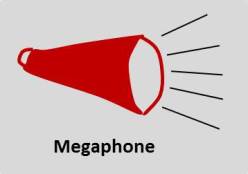
(ii) Stethoscope is used for listening the sound of heart and lungs by doctors. The sound reaches to the doctor by multiple reflection of sound in stethoscope.
(iii)The ceiling of the concert halls, conference halls and cinema halls are curved to reflect sound and after reflection sound reached to the every corner of the hall.
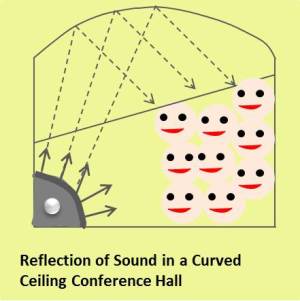
Sometime soundboard placed behind the staged, so that sound reflects from the sound board and spreads evenly across the width of the hall.
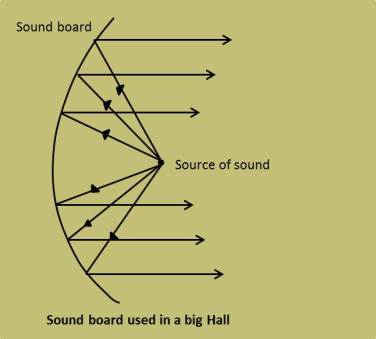
(14) Sonar represents Sound Navigation And Ranging.
It is device which is used to measure the distance, direction and speed of underwater objects by using ultrasonic waves.
It consists of a transmitter and a detector and is installed in a boat or a ship.
The transmitter produces ultrasonic waves and transmitted them. These waves travel through underwater and after striking the object on the seabed, they get reflected back. The detectors sensed them and converts ultrasonic waves into electrical signals which is interpreted. The distance of the object inside the sea can be calculated by multiplying speed of the sound and time interval between transmission and reception of the ultrasound.

Let time interval between transmission and reception of the ultrasound = t
Let speed of the sound through seawater = v
The total distance 2d = vt
This method is called echo – ranging. The sonar technique is used to determine the depth of the sea and to locate underwater hills, valleys, submarine, icebergs, sunken ships etc.
(15) In humans, the sound is produced by the voice box or the larynx. It is the upper end of the windpipe. Two vocal cords are stretched across the voice box. These vocal cords leave a slit between them for the air through by lungs to pass from it. When air passes from the slit, cords vibrate and produce sound. The quality of voice depends upon the tight and loose of the cord.
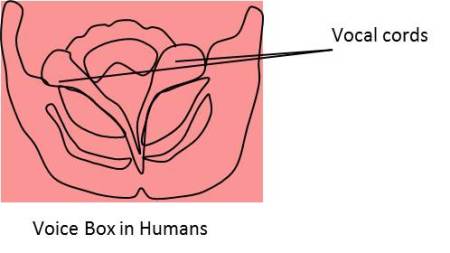
It can be feel by us by touching our throat, a hard part which moves up and down when we swallow is voice box.
(16) The voices of the man, women and children are different because of different length of their vocal cords. The length of vocal cord of men is about 20 mm. The length of vocal cord of women is 5 mm shorter. Children have very short vocal cords.
(17) The outer ear is called pinna which collected sounds from the surroundings and passes through the auditory canal. At the end of the auditory canal there is is a thin membrane called eardrums. The eardrum is like a stretched rubber sheet. When our ear receives compression of medium reaches the eardrum the pressure on the outside of the membrane increases and forces the eardrums inward. Similarly, eardrums move outward when a rarefaction of the medium reaches to the eardrum. In this way eardrum begins vibrate and sends vibrations to the inner ear. The vibrations are amplified several times by three bones (The hammer, anvil and stirrup) in the middle ear. The middle ear transmits the amplified pressure variations to the inner ear. Here, the pressure variations are turned in to electrical signals are sent by the cochlea. These electrical signals are sent to the brain via the auditory nerve and the brain interprets them as sound.

(18) Audible sound-
The frequencies of sound which humans can hear are known as audible sound. The range of audible frequencies of human ear is approximately from 20 to 20,000 Hz.
(19) Inaudible sound-
The frequencies of sound which humans cannot hear are known as inaudible sound. The range of inaudible frequencies of human ear is less than 20 Hz and higher than 20,000 Hz.
(i)Infrasound-
Sound of frequencies below 20 Hz is known as infrasound. Rhinoceroses, elephant, whales can hear infrasonic sounds. Earthquakes also produce infrasonic sounds before the main shock wave.
(ii)Ultrasound-
Sound of frequencies above 20 kHz is known as ultrasonic sound or ultrasound. Dolphins, bats can hear ultrasound.
Bats emits and detects reflections of ultrasonic waves. The high – pitched ultra-sonic waves reached to the bat’s ear after reflecting from the obstacles or prey. Then, the bat comes to know place of the prey or obstacle. Therefore, the bat can catch its prey.
Uses of high frequency sounds-
(i) Some animals like dog can hear sound frequency more than 20,000 Hz. The police high frequencies whistle which can be heard by dogs but humans can not hear that sound.
(ii) It is used for cleaning purpose of spiral rod, electronic components, odd shaped parts etc. The object is placed in a cleaning solution and ultrasonic waves are sent into the solution. Due to the high frequency, the particles of dust, grease get detached and drop out. Therefore, the object gets cleaned.
(iii) Ultrasounds can be used to detect cracks and flaws in metal blocks.
Ultrasonic waves are allowed to pass through the metal blocks and detectors are used to detect the transmitted waves. If there is very small flaw or defect, the ultrasound gets reflected back warning the presence of defect.
(iv) Ultrasonic waves are made to reflect from various part of the heart and form an image of the heart. This technique is called `echocardiography’.
(v) Ultrasound scanner is used ultrasonic waves for getting images of internal organ of our body such as liver, kidney, gall bladder, uterus etc. to detect stone or tumours. In this technique, ultrasonic waves travel in our body and get reflected from a region where tissue density is changed. These waves then converted into electrical signals that are used to generate images of the organs. These images are displayed on a monitor or printed on a film. This technique is called “ultrasonography”. This technique is also used in examining abnormalities in the foetus.
(vi) Ultrasound is also used to break stones formed in kidneys in to fine grains which flushed out with urine.
(20) The sounds which are unpleased or unwanted are known as noise.
Eg:- (i) Sound of vehicles.
(ii) Sound at construction site.
(21) The sounds produced by the musical instruments are known as musical sound.
Eg:- Sounds produced by the guitar or other musical instruments.
(22) The excessive unwanted sounds present in the environment are known as noise pollution.
Eg:- (i) Sounds of crackers
(ii) Sound of vehicles
(iii) Sound of machines etc.
Harms of the noise pollution
(i) Noise pollution caused lack of sleep.
(ii) Noise pollution caused hypertension (high blood pressure)
(iii) Noise pollution also caused anxiety.
(iv) Noise pollution also caused temporary or permanent hearing impairment.
Measures to limit noise pollution
(i) Silencing devices should be used in vehicles, machines and aircraft.
(ii)Use of automobile horns should be minimized in residential areas.
(iii) Music system and television should be listen at low volume.
(iv) Trees should be plants near residential area and along the road side to cut sound the sounds reaching to residents.
Helping Topics